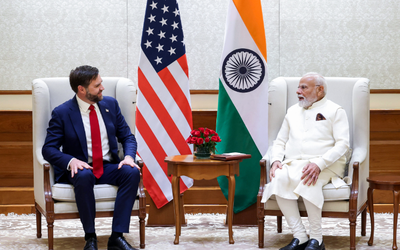More on International






The Indo-China discord over sharing of the Brahmaputra waters has prevented the development of hydropower potential in the northeast, including Arunachal Pradesh, considered to be the 'future powerhouse' of India.
An estimated 63,000 MW or 43 per cent of total identified hydro potential of the country is concentrated in the north eastern (NE) states including Arunachal Pradesh, which has come to be known as the 'future powerhouse of the country'. Despite internal impediments like lack of infrastructure, remote location and environmental concerns, the region has seen increasing interest in development of this potential. However, China's intentions of utilizing these water resources from upstream Brahmaputra, can significantly scuttle the plans for this development.
India's power generation capacity is estimated to grow from 190 GW in 2012 to more than 300 GW by 2020. Traditionally, India has depended on thermal power, both coal and natural gas based plants, to meet this growing demand. While we have about 39 GW of installed hydro capacity, the government is keen on tapping the remaining 110 GW hydro potential. Hydropower generation being eco friendly is also critical from the overall emission control plans of the country. The north east region accounts for an estimated 43 per cent (63,257 MW) of the total identified potential of the country. This is due to large water flows through the Brahmaputra basin and the unique topography. The Brahmaputra drainage area is spread across Arunachal Pradesh (42 per cent), Assam (33 per cent), Meghalaya (6 per cent), Nagaland (6 per cent) and Arunachal Pradesh, which gets the upstream drainage area, accounts for almost 50,000 MW of identified capacity (80 per cent of the north east region's potential capacity). But, in terms of real development, only 2 per cent (1158 MW) of total identified potential in the north east region has been developed as against 46 per cent (37690 MW) in the remaining part of the country. Ranganadi (405 MW) is the only large hydropower plant operational as of now in Arunachal Pradesh, which was developed by NEEPCO. Even this project has seen protests over downstream flooding impacts since its commissioning in 2003-2004. The key reasons for the lack of development in the region includes lack of physical infrastructure, erratic weather, difficult terrain, local insurgency, land acquisition and issues around environmental clearances. Concerns have been raised in the past on the EIA reports of projects such as the 2000 MW Lower Subansiri, 600 MW Kameng, etc. for incompletely assessing downstream impact on wildlife of the region. There is growing resentment amongst occupants in downstream states against the impacts of upstream dam construction specially after cases like the June 2008 flooding of Assam districts due to sudden releases from the 405 MW Ranganadi HEP.
In face of such challenges, both the central and state governments have tried to evolve a regional hydro development plan including the '50,000 MW hydro initiative' in 2003 and North Eastern Industrial and Investment Promotion Policy (NEIIPP) 2007, which has led to the development of a number of hydro assets by state and central players like NHPC (500 MW Teesta V in Sikkim, 105 MW Loktak in Manipur), NEEPCO (405 MW Ranganadi in Arunachal Pradesh, 275 MW Kopili in Assam), etc. With gradual opening of this sector, a number of projects have also been awarded to private developers, especially in Arunachal Pradesh.
Apart from the existing domestic bottlenecks, a major threat going forward for successful large scale development of hydropower in the region and specifically in Arunachal Pradesh, is India's long standing dispute with China over matters relating to water sharing and territorial rights. This threat from China has specifically come into prominence in the last few years due to China's aggressive plans of ramping up its hydropower and utilizing the fresh water resource from upstream Brahmaputra, thereby posing serious concerns over India's hydro plans in the region.
China's power and water imbalance
Currently, almost 79 per cent of China's power generation is sourced from coal, making it the world's largest coal consumer and the largest carbon dioxide emitter. Despite being the world's largest producer of coal, China also happens to be the second largest importer. China's over dependence on coal to feed its industrial and power requirements has now become a global concern. There is a clear thrust from the Chinese government towards development of alternative energy sources. The 12th Five Year Plan targets to increase the proportion of non-fossil fuels to 11.4 per cent by 2015 from 9.4 per cent in 2011 and hydro based power generation has become the next major focus area for China.
Power imbalance due to coal is not the only resource crisis that China is facing. Water disparity in the region is at such extreme that while droughts have caused 300 billion yuan losses since 1990's, floods too have caused damages of over 110 billion yuan during the same time period. These imbalances in water availability across northern and southern regions have increased over the years. While the south receives 80 per cent of China's rainfall, the industrial and population growth is focused around the northern and eastern region of China, thereby putting additional pressure on north China's limited water supply. As a result, the country is becoming drier each year as its freshwater reserves have declined 13 per cent between 2000 and 2009. In order to curb these imbalances, China is looking at more extensively using the resources from the water rich southern region and re-distribute it to the water scarce northern and eastern parts of the country.
China's hydro solution and implications for India
China has put forward massive plans for harvesting water resources and generating power via hydro development across the country. As per the 12th Five Year Plan, China is eyeing an installed hydro capacity of almost 350 GW by 2020, which is a capacity addition of almost 140 GW from 2011 installed capacity levels. Such a plan can only be achieved by aggressive development of a large number of dams and hydropower projects across its Tibetan Plateau region. Such is the importance of Tibetan water resources that authors and experts have been talking about themes like 'Tibet's Waters Will Save China' in the long run. This makes the world's highest river, Brahmaputra or the Yarlung Tsangpo (as known in Tibet) amongst the mainstay of China's plans to meet its burgeoning water and power demand. The river cuts through the rooftop of the world and flows across the entire Tibet before it takes a 'great bend' to enter north east India. China has identified the Yarlung Tsangpo Gorge at the bend as a potential site for two megahydro projects which would dwarf the size of world's largest Three Gorges dam (22,500 MW). At this site, the Tsangpo falls from 3000 m to almost 500 m within a span of 3 km length and also doubles its flow. This unique topography and major shift in water flow has allowed China to formulate plans for two dam projects namely Motuo, with 38,000 MW capacity and the Daduo with 43,800 MW generating capacity. Both these projects would involve diverting water from its natural course during construction and eventually holding up substantial flow upon completion.
Apart from these mega projects, China also has plans of various other smaller hydro project developments in the Tibet plateau region. These plans pose serious doubts about water availability in the downstream Brahmaputra and on India's ambitious hydro development plans in Arunachal Pradesh. Such concerns can be assessed through the impact of ongoing construction of 500 MW Zangmu dam project on upstream of Tsangpo, which may have led to a decrease of 30 per cent flow in Brahmaputra's Assam region during monsoons. Chinese officials have still not confirmed that water will not get diverted from Tsangpo river as a part of their South to North Water Diversion (SNWD) project which aims at connecting the 4 major rivers of China - Yangtze, Yellow River, Huaihe and Haihe. However, such large scale hydro development in the Tibetan plateaus region and the absence of any bilateral water treaty between India and China, leaves a possibility for China to divert water from upstream Brahmaputra system for its usage. Thus, it is imperative for India's hydro plans that we work out a clear water resource sharing treaty over the Brahmaputra river. The treaty could be modeled over the 1997 UN Convention on the Law of Non- Navigational Uses of International Watercourses or the 1960 Indus Water Treaty between India and Pakistan. However, there has been very little progress shown by the Chinese over such proposals of resource sharing not just with India but with other south-east Asian countries like Vietnam, Cambodia, Thailand and Laos, who face a similar situation in the downstream of Mekong river.
In addition to the issue of water sharing, China has also maintained a claim over the territorial rights for Arunachal Pradesh and does not recognize India's control over the region, describing Arunachal as 'Southern Tibet'. In the past, China has impeded major infrastructural developments in the region by opposing funding sought by India at international forums for developing hydro projects in Arunachal Pradesh. It opposed a US$2.9 billion Asian Development Bank (ADB) loan to India in March 2009 because it included funding for a $60 million flood management and hydro program in Arunachal Pradesh. Hence, any hydro developments could also face roadblocks from China towards securing multi-national loans/aids from international organizations like World Bank, ADB, etc. and may also not get assistance from Chinese equipment and technology players. Despite being touted as the 'future powerhouse of the country', Arunachal Pradesh and north east may continue to remain a pipedream, unless the Indian government is able to tame the mighty dragon and push through a clear water sharing agreement for the Brahmaputra.
(The writer is Partner and Managing Director, Strategic Decisions Group)
http://www.power-eng.com/news/2012/07/19/playing-chinese-checkers-with-india-s-hydro-sector.html








